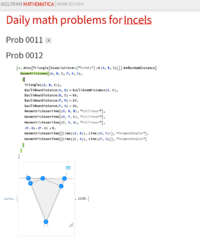Yes
Maybe this wikipedia article has the one youre thinking of

en.m.wikipedia.org
I'll look it up after tbh
Let's just try to brute force for now, since it seems peaceful enough
1/2 * sin(135) * y3 * 7 + 1/2 * sin(45) * x3 * 7 = x1* y1 * 1/2
1/2 * sin(45) * y3 * 1 + 1/2 * sin(135) * x3 * 1 = x2* y2 * 1/2
lets simplify these 2 for now
since sin 135 and sin 45 are 1/sqrt(2)
x1*y1*sqrt(2) = 7y3 + 7x3
x2*y2*sqrt(2) = y3 + x3
lol I think this just derived the chord theorem
x1*y1 = 7*x2*y2
adding some Pythagoras stuff with the "height"
x1^2 = (x3 - 7/sqrt2)^2 + ( 7/sqrt2)^2
y1^2 = (y3 + 7/sqrt2)^2 + ( 7/sqrt2)^2
x2^2 = (x3 + 1/sqrt2)^2 + ( 1/sqrt2)^2
y2^2 = (y3 - 1/sqrt2)^2 + ( 1/sqrt2)^2
So the complete list of equations so far is :
x1^2 + y1^2 = x2^2 + y2^2 = (x3 + y3)^2
x1*y1 = 7*x2*y2 = (y3 + x3) * 7/sqrt2
x1^2 = (x3 - 7/sqrt2)^2 + ( 7/sqrt2)^2
y1^2 = (y3 + 7/sqrt2)^2 + ( 7/sqrt2)^2
x2^2 = (x3 + 1/sqrt2)^2 + ( 1/sqrt2)^2
y2^2 = (y3 - 1/sqrt2)^2 + ( 1/sqrt2)^2
which looks like it should be enough...
Lets start with
x1^2 + y1^2 = (x3 + y3)^2
(x3 - 7/sqrt2)^2 + ( 7/sqrt2)^2 + (y3 + 7/sqrt2)^2 + ( 7/sqrt2)^2 = (x3 + y3)^2
- 7 * sqrt2 * x3 + 49/2 + 49/2 + 7 * sqrt2 * y3 + 49/2 + 49/2 = 2 * x3 * y3
An nice, I think this somewhat solves things









